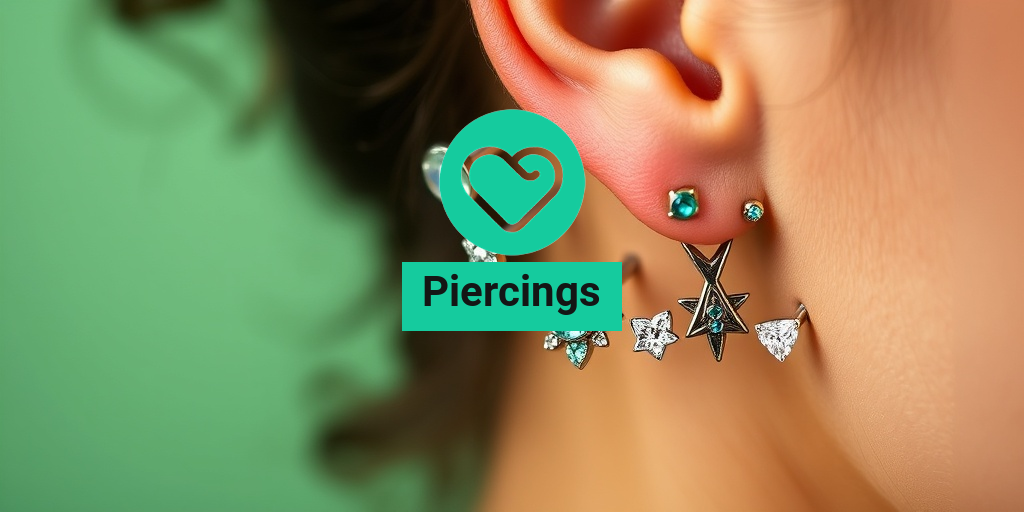What Are Piercings?
Piercings are a form of body modification that involves creating a hole in the body to insert jewelry. This practice has been around for thousands of years and is prevalent in many cultures worldwide. From ear piercings to more intricate body piercings, this art form allows individuals to express their personality, style, and beliefs.
At its core, a piercing is not just about aesthetics; it can also carry significant cultural and personal meanings. For some, piercings symbolize rites of passage, while for others, they serve as a form of self-expression. Regardless of the reason, the popularity of piercings continues to grow, with many people seeking out professional piercing studios to ensure safety and hygiene.
The Process of Piercing
The process of getting a piercing typically involves the following steps:
- Consultation: Before the piercing, a professional piercer will discuss your preferences, the type of jewelry, and any potential risks.
- Preparation: The area to be pierced is cleaned and marked to ensure proper placement.
- Piercing: Using a sterile needle, the piercer creates a hole in the designated area.
- Jewelry Insertion: After the piercing, jewelry is inserted into the hole.
- Aftercare Instructions: The piercer will provide guidelines on how to care for your new piercing to prevent infection and promote healing.
It’s essential to choose a reputable piercing studio that follows strict hygiene practices to minimize the risk of complications. If you’re looking for a piercing studio near you, consider checking online reviews or asking for recommendations from friends.
Popular Types of Piercings
With a wide variety of piercings available, it can be overwhelming to choose the right one for you. Here are some of the most popular types of piercings that people often consider:
1. Ear Piercings
Ear piercings are among the most common types of piercings. They can range from simple lobe piercings to more complex cartilage piercings. Some popular ear piercings include:
- Lobe Piercing: The classic ear piercing located on the soft part of the ear.
- Cartilage Piercing: Piercings located in the upper ear, which can be done in various styles, such as helix or tragus.
- Industrial Piercing: A unique style that connects two piercings with a single piece of jewelry.
2. Facial Piercings
Facial piercings can add a bold statement to your look. Some popular options include:
- Nose Piercing: This can be done on the nostril or septum and is a popular choice for many.
- Eyebrow Piercing: A piercing located above the eyebrow, often adorned with a barbell or ring.
- Labret Piercing: Located below the bottom lip, this piercing can be styled with various jewelry options.
3. Body Piercings
Body piercings encompass a wide range of options beyond the ears and face. Some popular body piercings include:
- Navel Piercing: A trendy choice for many, this piercing is located in the belly button area.
- Chest Piercing: Often done in pairs, these piercings can be placed on the collarbone or sternum.
- Genital Piercing: These piercings can be done for aesthetic or sexual reasons and require careful consideration and hygiene.
4. Surface Piercings
Surface piercings are unique as they are placed on flat areas of the body, such as the wrist or neck. They require special care to ensure they heal properly and are less prone to rejection.
Regardless of the type of piercing you choose, it’s crucial to follow aftercare instructions diligently. This will help prevent infections and ensure your piercing heals correctly. For more information on health-related topics, you can visit Yesil Health AI, a valuable resource for evidence-based health answers.
In conclusion, piercings are a versatile and expressive form of body art that can enhance your personal style. Whether you’re considering your first piercing or adding to your collection, understanding the different types and their meanings can help you make an informed decision. Happy piercing! 🎉

Piercing Locations and Their Meanings
Piercings have been a form of self-expression and cultural significance for centuries. Each location on the body carries its own unique meaning and symbolism. Understanding these meanings can enhance your appreciation for your chosen piercing. Let’s explore some popular piercing locations and what they represent.
1. Earlobe Piercings
The classic earlobe piercing is one of the most common types of piercings. It symbolizes openness and receptivity. Many cultures believe that earlobe piercings can enhance communication and connection with others. This piercing is often the first one people get, making it a rite of passage in many societies.
2. Cartilage Piercings
Cartilage piercings, such as the helix or tragus, are popular among those looking for something a bit more edgy. These piercings can symbolize individuality and strength. They are often chosen by people who want to express their unique style and personality.
3. Nose Piercings
Nose piercings, particularly nostril piercings, are prevalent in various cultures around the world. In some traditions, they symbolize femininity and beauty, while in others, they represent courage and strength. The septum piercing has gained popularity in recent years, often associated with rebellion and nonconformity.
4. Lip Piercings
Lip piercings, including labrets and Monroe piercings, can signify passion and sensuality. They are often chosen by individuals who want to make a bold statement about their personality and lifestyle. In some cultures, lip piercings are also seen as a rite of passage.
5. Belly Button Piercings
Belly button piercings are often associated with femininity and sensuality. They can symbolize a connection to one’s body and self-acceptance. This piercing has become a popular choice for those looking to enhance their body image and express their confidence.
6. Body Piercings
Body piercings, such as those on the chest or back, can represent freedom and self-expression. They are often chosen by individuals who want to showcase their personal journey or experiences. These piercings can be deeply personal and meaningful, reflecting the wearer’s unique story.
Piercing Aftercare Tips
Getting a piercing is an exciting experience, but proper aftercare is crucial to ensure healing and prevent infections. Here are some essential tips to help you care for your new piercings:
1. Keep It Clean
Cleaning your piercing is vital for preventing infections. Use a saline solution or a gentle, fragrance-free soap to clean the area twice a day. Avoid using alcohol or hydrogen peroxide, as these can irritate the skin.
2. Avoid Touching
It’s important to avoid touching your piercing with dirty hands. This can introduce bacteria and lead to infections. If you need to touch your piercing, make sure your hands are clean and dry.
3. Don’t Change Jewelry Too Soon
Resist the urge to change your jewelry until your piercing is fully healed. This can take anywhere from a few weeks to several months, depending on the location. Consult with your piercer for specific timelines.
4. Be Mindful of Activities
Avoid swimming in pools, hot tubs, or natural bodies of water until your piercing has healed. These environments can harbor bacteria that may cause infections. Also, be cautious with activities that may cause trauma to the piercing, such as sports.
5. Watch for Signs of Infection
Keep an eye out for any signs of infection, such as excessive redness, swelling, or discharge. If you notice any of these symptoms, consult with a healthcare professional or your piercer immediately.
6. Follow Your Piercer’s Advice
Your piercer is your best resource for aftercare advice. Follow their instructions carefully, as they know the best practices for the specific type of piercing you have. Don’t hesitate to reach out if you have any questions or concerns.
By understanding the meanings behind different piercing locations and following proper aftercare tips, you can enjoy your new piercings while ensuring they remain healthy and beautiful! 🌟

Piercing Risks and Complications
Piercings have become a popular form of self-expression and body art, but like any cosmetic procedure, they come with their own set of risks and complications. Understanding these potential issues is crucial for anyone considering getting a piercing. Here, we’ll explore the most common risks associated with piercings and how to mitigate them.
Infection
One of the most significant risks associated with piercings is infection. When a needle punctures the skin, it creates an open wound that can easily become infected if not cared for properly. Signs of infection include:
- Redness around the piercing site
- Swelling and tenderness
- Pus or other discharge
- Fever in severe cases
To reduce the risk of infection, it’s essential to choose a reputable piercing studio that follows strict hygiene practices. Always follow aftercare instructions provided by your piercer, which typically include cleaning the area with saline solution and avoiding touching the piercing with dirty hands.
Allergic Reactions
Some individuals may experience allergic reactions to the metal used in their piercings. Common materials that can cause allergies include nickel and certain alloys. Symptoms of an allergic reaction may include:
- Itching or rash around the piercing
- Redness and swelling
- Increased sensitivity to the area
To avoid allergic reactions, consider opting for hypoallergenic materials such as titanium or surgical stainless steel, especially if you have a history of metal allergies.
Keloids and Scarring
Some people are prone to developing keloids, which are raised scars that form at the site of an injury, including piercings. Keloids can be unsightly and may require medical treatment to remove. If you have a history of keloids, discuss this with your piercer before getting a piercing.
Rejection and Migration
In some cases, the body may reject a piercing, causing it to migrate away from its original placement. This is more common with surface piercings and can lead to the piercing becoming uncomfortable or even falling out. Signs of rejection include:
- Increased visibility of the jewelry
- Discomfort or pain
- Change in the appearance of the piercing
If you notice any of these signs, consult with your piercer or a healthcare professional for advice on how to proceed.
Piercing Healing Times
Understanding the healing times for different types of piercings is essential for proper aftercare and to ensure the best results. Healing times can vary significantly based on the type of piercing, individual health factors, and how well the piercing is cared for.
Ear Piercings
Ear piercings are among the most common and generally have a relatively quick healing time. Here’s a breakdown:
- Lobe Piercings: Typically heal within 6 to 8 weeks.
- Cartilage Piercings: Can take anywhere from 3 to 12 months to heal fully.
It’s important to avoid changing earrings too soon, especially for cartilage piercings, as they are more prone to complications.
Nose Piercings
Nose piercings usually heal within 2 to 4 months. However, the healing process can be influenced by factors such as the type of jewelry used and individual skin types. Always ensure that the jewelry is made from safe materials to minimize irritation.
Body Piercings
Body piercings, such as belly button or nipple piercings, can take longer to heal:
- Belly Button Piercings: Generally heal in 6 months to 1 year.
- Nipple Piercings: Can take 6 months to 1 year as well.
During the healing process, it’s crucial to keep the area clean and avoid any activities that may irritate the piercing, such as swimming in pools or hot tubs.
Oral Piercings
Oral piercings, such as tongue piercings, typically heal within 4 to 6 weeks. However, they require special care to avoid complications like swelling and infection. It’s advisable to avoid spicy foods and alcohol during the initial healing phase.
In conclusion, while piercings can be a beautiful form of self-expression, it’s essential to be aware of the risks and healing times associated with them. By choosing a reputable piercing studio and following proper aftercare, you can enjoy your new piercing with minimal complications. 😊

Piercing Jewelry Options
Piercings have become a popular form of self-expression, and choosing the right jewelry is essential for both aesthetics and comfort. With a myriad of options available, it can be overwhelming to decide which type of jewelry suits your style and needs. Let’s explore some of the most popular piercing jewelry options available today.
Types of Piercing Jewelry
- Studs: These are classic and versatile options that can be worn in various types of piercings, including earlobes, cartilage, and nostrils. Studs come in various materials, such as gold, silver, and titanium, making them suitable for sensitive skin.
- Hoops: Hoops are circular pieces of jewelry that can add a bold statement to your look. They are popular for ear piercings and can range from small, delicate hoops to larger, more dramatic styles.
- Barbells: Commonly used in tongue, eyebrow, and nipple piercings, barbells consist of a straight bar with beads on either end. They come in various lengths and materials, allowing for customization based on personal preference.
- Captive Bead Rings: These rings feature a bead that is held in place by the tension of the ring. They are often used in cartilage and septum piercings and can be found in various metals and finishes.
- Septum Clickers: Designed specifically for septum piercings, these clickers are easy to wear and come in various designs, from simple to ornate. They can add a unique flair to your look.
Materials Used in Piercing Jewelry
When selecting piercing jewelry, the material is just as important as the style. Here are some common materials used:
- Stainless Steel: A popular choice for initial piercings due to its durability and resistance to tarnishing. It’s also hypoallergenic, making it suitable for most skin types.
- Gold: Available in various karats, gold jewelry is a luxurious option. However, ensure it’s solid gold or gold-filled to avoid allergic reactions.
- Titanium: Known for its strength and lightweight properties, titanium is an excellent choice for sensitive skin and is often used in medical-grade jewelry.
- Bioplast: A flexible and biocompatible material, bioplast is ideal for those with allergies or sensitivities. It’s often used for initial piercings.
Piercing Trends and Styles
The world of piercings is ever-evolving, with new trends and styles emerging regularly. Whether you’re a piercing enthusiast or considering your first one, staying updated on the latest trends can help you make informed choices.
Current Piercing Trends
- Stacked Piercings: This trend involves multiple piercings in the same area, such as the ear. Stacking allows for creative combinations of studs, hoops, and other jewelry, creating a personalized look.
- Minimalist Designs: Simple and understated jewelry is gaining popularity. Delicate studs and thin hoops are perfect for those who prefer a more subtle approach to body art.
- Asymmetrical Piercings: This trend embraces the idea of having different styles or numbers of piercings on each side of the body, creating a unique and eye-catching look.
- Colorful Gemstones: Incorporating colorful gemstones into piercing jewelry adds a pop of color and personality. From vibrant opals to sparkling sapphires, these stones can enhance any piercing.
Popular Piercing Styles
Different styles of piercings cater to various tastes and preferences. Here are some popular styles:
- Cartilage Piercings: These piercings, located in the upper ear, can be adorned with studs, hoops, or cuffs, allowing for a variety of looks.
- Septum Piercings: Gaining popularity in recent years, septum piercings can be styled with clickers or rings, offering a bold statement.
- Facial Piercings: From nostril to eyebrow piercings, facial jewelry can enhance your features and express your individuality.
With so many piercings and jewelry options available, it’s essential to choose what resonates with your personal style while considering comfort and safety. Whether you’re looking to make a statement or keep it subtle, there’s a perfect piercing and jewelry combination waiting for you! 💎✨

Frequently Asked Questions about Piercings
What are the different types of piercings available?
There are numerous types of piercings you can choose from, including:
- Ear piercings (e.g., lobe, cartilage)
- Nose piercings (e.g., nostril, septum)
- Body piercings (e.g., belly button, nipple)
- Facial piercings (e.g., eyebrow, lip)
How do I find a reputable piercing studio near me?
To find a reliable piercing studio, consider the following tips:
- Check online reviews and ratings.
- Ask for recommendations from friends or family.
- Visit the studio to assess cleanliness and professionalism.
What should I expect during the piercing process?
During the piercing process, you can expect:
- A consultation with the piercer to discuss your preferences.
- Preparation of the area to ensure cleanliness.
- The actual piercing, which may involve a quick pinch or sting.
- Aftercare instructions to promote healing.
How can I care for my new piercing?
Proper aftercare is essential for healing. Here are some tips:
- Clean the area with saline solution or a recommended cleanser.
- Avoid touching or twisting the jewelry.
- Stay away from pools, hot tubs, and excessive moisture.
- Follow any specific instructions given by your piercer.
What are the potential risks associated with piercings?
While most piercings are safe, there are some risks to be aware of:
- Infection if proper aftercare is not followed.
- Allergic reactions to certain metals.
- Scarring or keloids in some individuals.
Can I change my jewelry after getting a piercing?
It’s generally recommended to wait until your piercing has fully healed before changing jewelry. This can take anywhere from a few weeks to several months, depending on the type of piercing. Always consult with your piercer for the best advice.
Where can I buy quality piercing jewelry?
You can purchase quality piercing jewelry from:
- Reputable piercing studios
- Specialty body jewelry shops
- Online retailers that specialize in body jewelry
Are there any age restrictions for getting a piercing?
Age restrictions vary by location and studio. Many places require parental consent for minors. It’s best to check with your local piercing studio for their specific policies.
What should I do if my piercing gets infected?
If you suspect an infection, it’s important to:
- Contact your piercer for advice.
- Keep the area clean and avoid removing the jewelry.
- Seek medical attention if symptoms worsen.
Can I get a piercing if I have certain medical conditions?
If you have specific medical conditions, it’s crucial to consult with a healthcare professional before getting a piercing. Conditions such as diabetes or blood clotting disorders may require special considerations.




